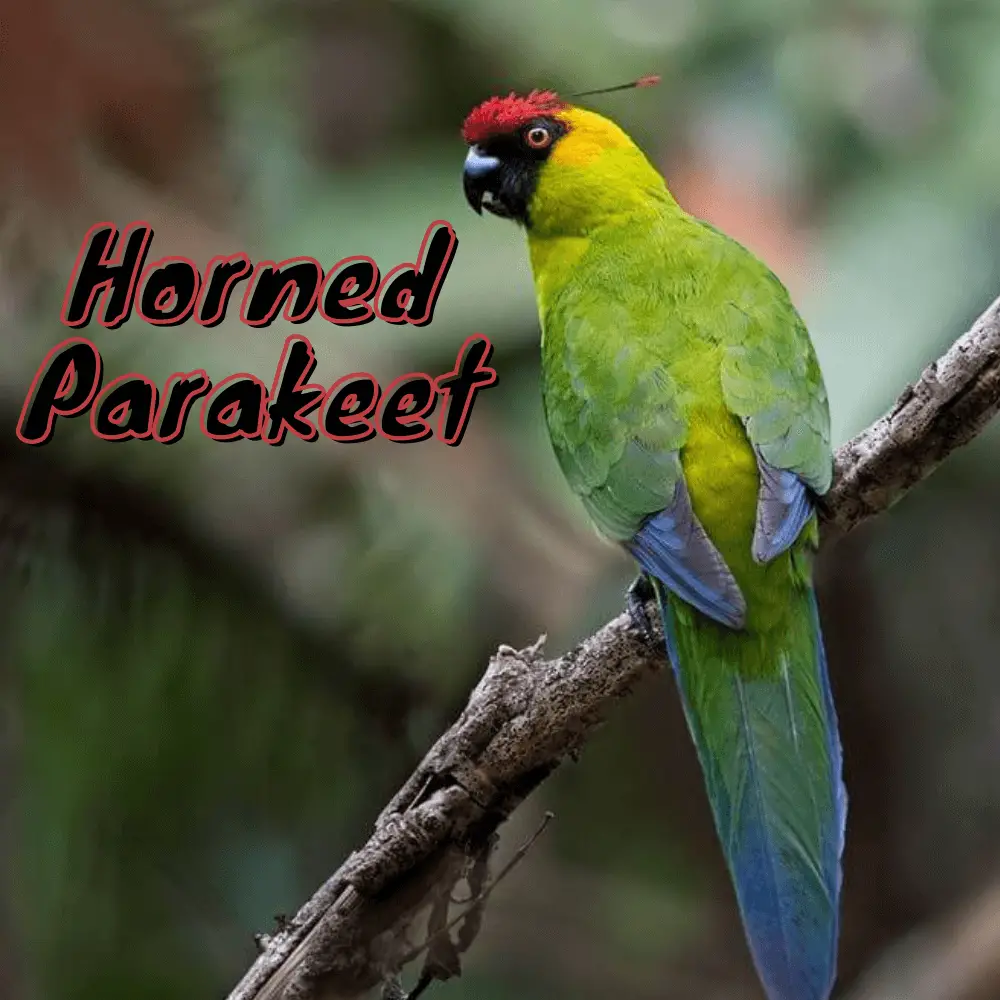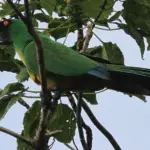
Horned Parakeet 32 cm; male 167 g, female 125 g. Generally green, more yellowish on underparts, with rump, ear-coverts, and nape greenish-yellow;
forehead to mid-crown red with several (usually two), long, red-tipped black crest-feathers (60–70 mm); front of face around the eye to chin smudgily black; outer webs of primaries violet-blue;
tail distally shaded violet, lateral feathers violet tipped whitish. Bare parts: bill blue-grey tipped black, iris orange, and legs and feet black.
Sexes alike, but Horned Parakeet females are smaller in most biometrics. Immature has greyer and less extensive facial markings, pale green ear-coverts, olive-green hindneck; bill horn-colored, iris brown.
Differs from sympatric Cyanoramphus novaezelandiae saisseti by head pattern, bluer, longer, and more rounded tail, and larger, stouter structure, and from Trichoglossus haematodus deplanchii by lack of dark purple head and red breast, slower flight, and different habits.
Formerly conspecific E. uvaeensis, confined to the island of Ouvea, lacks yellow tinging on the head, with more crest feathers, all green, and red more restricted on the crown.
Systematics History
Until recently, generally considered conspecific with E. uvaeensis (which see). Monotypic.
Subspecies
Monotypic.
Distribution
New Caledonia.
Habitat
Forests up to 30 m tall), notably Agathis australis and Araucaria-dominated, as well as savannas, low-stature forest, and scrub in maquis and high mountains, but avoids coconut plantations and coastal areas. Commonest in humid valleys, especially on limestone soils, and recorded to 1500 m.
Movement
Sedentary, but it may migrate seasonally to foraging grounds during austral winter (Jun-Sep). Parakeets are able to cross scrub between forest blocks, and species are not believed to be fragmented into distinct subpopulations.
Diet and Foraging
SOURCE: Moonbeetle
Berries of vines, seeds of various trees and shrubs, notably “penubre tree”, Agathis lanceolata, Lantana Camara, and Carica papaya.
Typically observed in pairs or small flocks of up to 6–10 birds, feeding high in the canopy, but sometimes observed in larger flocks Horned Parakeet feeding in savanna areas.
Sounds and Vocal Behavior
Noisy, giving repeated, nasal, raucous “khoo” or “kho-koot” Horned Parakeet calls, rather similar to those of New Caledonian Crow (Corvus moneduloides), but lower-pitched and more trumpeting, and more varied than those of sympatric Cyanoramphus novaezelandiae saisseti;
also gives softer chattering notes and range of shrieks (in alarm) and chuckling calls (when perched or feeding). Compared to E. uvaeensis,
calls are slower in tempo (especially food-begging calls) and higher-pitched (all call types), with the mate (contact) call being most different.
SOURCE: obirds
Breeding
Sept–Mar. Horned Parakeet Nest in a hole in the dead or living tree, species including Metrosideros demonstrans; sometimes on the ground, including under rocks and in fallen tree-trunks.
Two pairs sometimes share the same nest. Eggs 2–4, although usually only two young are reared, which reach a maximum weight of 180 g; in captivity, incubation lasts 21–22 days (by the female alone),
nestling period is 5–6 weeks. Breeding success: at 17 wild nests, mean clutch size 3·4 eggs, with mean number hatching 2·8 and mean a number of fledglings 1·9.
Conservation Status
VULNERABLE. CITES I. A BirdLife “restricted-range” species.
Has declined substantially since the 1880s owing to habitat loss and cagebird trade and may now number c. 8000–9000 individuals, equivalent to 5300–6000 mature individuals. Range much reduced on Mt Panié (now restricted to NW part).
Numbers and trends are poorly known; prior to 2003–2006 just two independent population estimates of 1000–3000 birds and 720 pairs, respectively.
A recent study using distance sampling density data, records, and ecological niche modeling indicates that species have wider distribution and are commoner than previously believed. During the 2003–2006 surveys,
Horned Parakeet was recorded from Ignambi massif in N of New Caledonia to various massifs of Grand Sud in S, being recorded on 57% of massifs in N and 42% of those in S. Absent from Île des Pins.
Locally common in the central part of the “chaîne” (Mé Maoya Massif, Moindou-Farino area, Poindimié-Ponérihouen area), while numbers have been stable in Rivière Bleue over last 20 years.
Any current decline might be due to habitat degradation, through logging and by introduced Rusa deer (Rusa timorensis), while black rats (Rattus rattus) occasionally prey on species’ nests, although this is unconfirmed. Particularly wet (La Niña) years reduce breeding success.
Little documented trapping or trade and, although there are captive birds on Grande Terre and birds are locally sought for trade, this seems to be marginal and since the species breeds in remote areas and its nests are hard to find, poaching is unlikely to be a major threat.
Occasional illegal hunting. The introduction of Psittacine Beak and Feather Disease could be a threat, but to date tests for the disease have proved negative in this species.




















